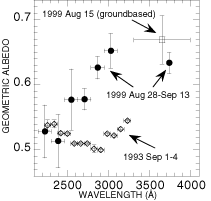
[Previous] | [Session 46] | [Next]
L.A. Young (SwRI), S.A. Stern (SwRI), M.W. Buie (Lowell Obs.), M.D. Hicks (JPL), B.J. Buratti (JPL), L.M. Trafton (Univ. TX at Austin), J.A. Stansberry (Steward Observatory)
We observed Triton using HST/STIS on 1999 Aug 28, Sep 11, and Sep 13. Images were taken at 271 nm and 374 nm, and spectra from 157 to 318 nm. Ground-based photometry from 1999 Aug 15 indicate that Triton had high geometric albedo in U, near 365 nm (0.67±0.04; Hicks and Buratti, in prep), and was not in its transient reddened phase on that date. We find that Triton's geometric albedo remains high through the NUV and MUV, decreasing from 0.64±0.02 at 374 nm to 0.48 ±0.07 at 220 nm. We can compare these data to a previous UV dataset obtained by HST/FOS from 1993 Sep 1--4 (Stern et al. 1995, AJ 109, 2855). Between 250 and 320 nm, Triton was roughly 20% brighter in the STIS (1999) dataset than in the FOS (1993) datset, while between 220 and 250 nm the albedos are unchanged. As predicted from the HST/FOS and previous datasets, we find that Triton had higher spatial contrast at shorter wavelengths at the time of our observations, but with a contrast that is roughly 30% lower than predicted by the model of Hillier et al. (1991, JGR 96, 19215). No absorption features were detected in the HST/STIS data, although there is the suggestion of an absorption edge near 250 nm.

The author(s) of this abstract have provided an email address for comments about the abstract: layoung@boulder.swri.edu